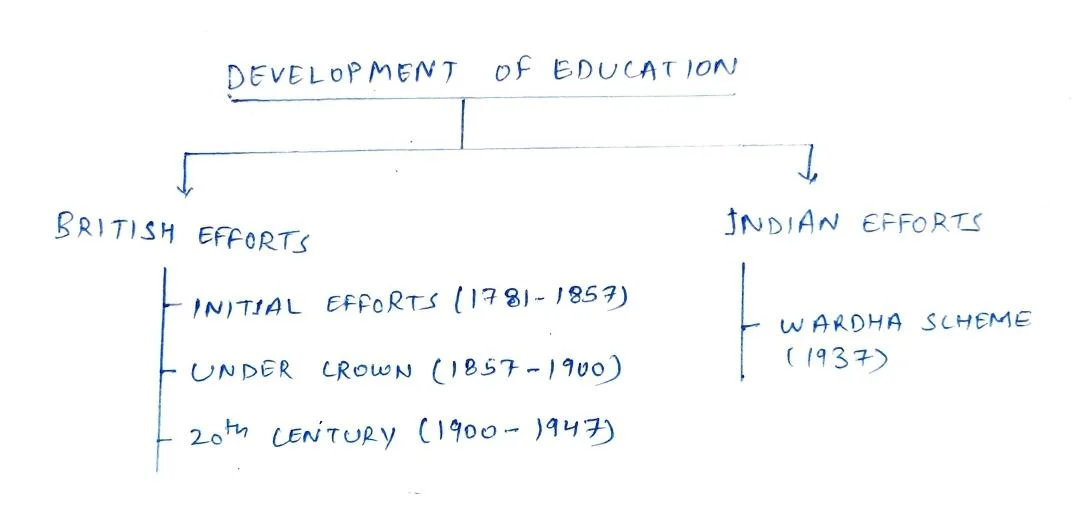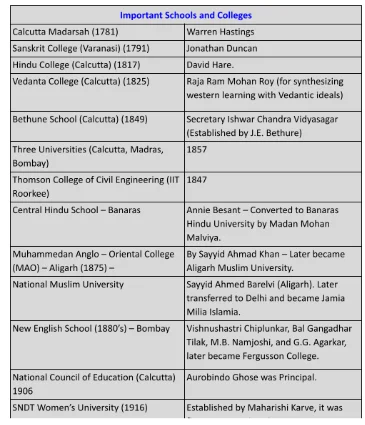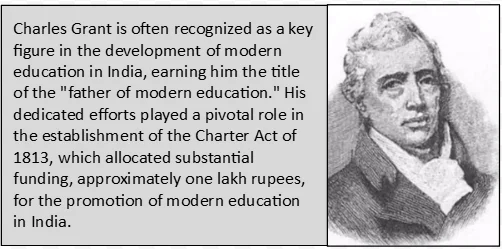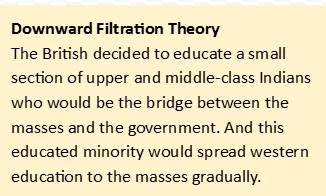The British colonial period marked a significant transformation in Indian education. Prior to British rule, India’s education was rooted in traditional institutions focusing on ancient texts. However, the rapid changes in the world necessitated an evolution in the education system. The British East India Company, while primarily interested in administrative and legal needs, laid the groundwork for modern education in India, leading to significant shifts in educational policies and practices.
Development of Education in India: Under the English East India Company
Early Educational Initiatives
- Introduction to Education in Colonial India: The British colonial period in India marked a pivotal moment in the development of education.
- Prior to British rule, education in India was rooted in traditional institutions like pathshalas, mastabas, and madrasas, focusing on ancient texts such as the Vedas.
- However, this system became outdated as the world rapidly evolved.
- Limited Interest by the British East India Company: The British East India Company, a dominant colonial force, displayed limited interest in promoting education in India.
- Instead, their establishment of educational institutions was primarily to ensure a supply of Indians for the Company’s law courts.
- Role of Classical Languages: The knowledge of classical languages was exploited to facilitate communication with native states. This policy significantly impacted Indian education.
- The development of the education system can be divided into the following:

Enroll now for UPSC Online Course
- Calcutta Madrasa (1781): It was founded by Warren Hastings, the Governor-General of Bengal, as a center for studying Islamic law.
-
- It was the first school established under the authority of the East India Company (EIC).
- Asiatic Society of Bengal (1784): Asiatic Society of Bengal was founded by William Jones to understand and study the history and culture of India.
- During this period Charles Wilkins translated Bhagwat Gita into English.
- Sanskrit College, Benares (1791): It was founded by Jonathan Duncan for the study of Hindu laws and philosophies.
- William College, Calcutta (1800): It was established by Governor-General Richard Wellesley, who wanted to teach Indian languages and customs to the EIC’s civil servants.
- However, the British government’s opposition to the Indianization of English civil personnel led to the college’s closure in 1802.

Charter Act of 1813
- Allocation for Education: This was the nation’s first significant move toward modern education under British rule.
- This act allocated Rs. 1 lakh per year for the education of Indian subjects.
- However, this small sum was not made available until 1823, primarily due to the heated debate over the appropriate course for this expenditure.
- Support for Calcutta College (1817): A grant was approved for Calcutta College, founded by educated Bengalis to provide English education in Western humanities and sciences.
- Establishment of Sanskrit Colleges: The government in Agra, Delhi, and Calcutta also established three Sanskrit colleges to promote the study of classical Indian languages and literature.
- Introduction of English Education: It also introduced English Education in India.
- Shortcomings of the Charter Act: The Charter Act encountered several shortcomings, leading to its failure for the following reasons:
- It did not specify the language to be used as the medium of instruction in educational institutions.
- The Act was unclear about the methods for promoting the growth of English education in India.
- It did not clearly articulate whether education should be accessible to all segments of the population or restricted to a select few.
Role of Christian Missionaries in the Development of Education

- The activities of Christian missionaries in India had a significant influence on the promotion of Western education by the British authorities.
- Notable English Missionaries: involved in this effort included Charles Grant and William Wilberforce.
- Missionaries’ Objectives: The Christian missionaries aimed to advance Western education in India with the belief that exposure to modern education might challenge traditional Indian religious beliefs and potentially lead to a greater acceptance of Christianity.
The Controversy: Orientalist vs Anglicist
During the first quarter of the nineteenth century, great controversy was going on regarding the nature of education and the medium of instruction in schools and colleges.
- The Orientalists: The Orientalists were in favor of the continuation of the existing institutions of oriental learning and the promotion of Indian classical tradition.
- They were led by Dr H.H. Wilson and H.T. Princep advocated in favor of Sanskrit, Arabic, and Persian as the medium of education.
- Hence, the establishment of the Calcutta Madrasa and the Benaras Sanskrit College took place.
- The Anglicists: The Anglicists led by Charles Trevelyan, and Elphinstone advocated the imparting of Western education, supported by most advanced Indians of the time, like Raja Ram Mohan Roy.
- They argued the idea of diffusing Western sciences and literature amongst the Indians.
- Divisions Among the Anglicists: Even the Anglicists were divided over the question of the medium of instruction
- One faction was for the English language as the medium, while the other faction was for Indian languages (vernaculars) for the purpose.
- Unfortunately, there was a great deal of confusion.
General Committee Of Public Instruction (1823)
- Objective: A “General Committee of Public Instruction ” was established by the Governor-General-in-Council in 1823 with the task of allocating one lakh rupees for educational purposes.
- Composition and Disagreement: Pertaining to the lack of a majority, the General Committee of Public Instruction was not able to decide the medium of instruction by vote.
- Out of 10 members of which Lord Macaulay was the president, 5 supporters of English language or Anglicist as the medium of instruction, and 5 supporters of oriental or classic language or Classicists as a medium of instruction.
- Lord Macaulay’s Minute (1835): Throughout his minute, Lord Macaulay emphasized the use of the English language as a medium of instruction.
Macaulay’s Minute (1835)/ The English Education Act of 1835
- Resolving the educational Dispute: The well-known Lord Macaulay’s Minute resolved the dispute in the Anglicists’ favor by directing the few government resources toward the instruction of Western literature and sciences.
- Emphasis on Western Superiority: Macaulay considered Western science to be superior to all.
- He had famously said that “a single shelf of a good European library was worth the whole native literature of India and Arabia”.
- Promotion of English as the Medium of Instruction: English should be made the medium of education in schools and colleges.
- Focus on Higher Education, Neglect of Mass Education: Elementary schools were not given importance, rather more schools at district levels and colleges were suggested to be opened. Hence, mass education was neglected.

Adam’s Report (Published in 1835, 1836, and 1838)
- William Adam’s Appointment and Mission: William Adam, a Unitarian missionary appointed by William Bentick, was tasked with investigating the state of education in rural Bengal.
- Advocacy for Vernacular Education: His mission was to assess literacy levels and funding sources for village schools.
- His report provided a comprehensive overview of the condition of both primary and secondary vernacular schools across various districts in Bengal.
- He advocated for a “Theory of General Rural Education” rooted in local vernacular village schools.
- Government Support for Vernacular Education: He believed that government support for vernacular education was the most effective way to modernize education in Bengal, even though it was costly.
- Training Local Teachers: He also suggested measures for training local teachers to enhance vernacular education.
- Disruption of the Orientalist-Anglicist Debate: His report disrupted the ongoing debate between Orientalists and Anglicists in Calcutta about the future of the Company Administration’s educational policy.
- Decline of the Pathshala System: Unfortunately, his recommendations were disregarded, leading to a decline in the Pathshala system as decreasing revenue and diminished local control hampered the villages’ ability to sustain their schools.
Thomson’s effort (1843–1853)
- Strategy for Village Education: James Thomson Lieutenant-governor of the Northwest Provinces created an exhaustive strategy for village education using vernacular languages.
- Practical Courses in Village Schools: Useful courses like agriculture science and menstruation were taught in these village schools.
- Training for Government Staff: The goal was to provide staff training for the recently established Revenue and Public Works Department.
Wood’s Despatch (1854): The Magna Carta of English Education in India
- Known as the “Magna Carta of English Education in India,” this document served as the initial all-encompassing scheme for the dissemination of education throughout the country.
- Promotion of European Knowledge and Indian Languages: The diffusion of European Arts, Science, Philosophy, and Literature through English was declared to be the goal of education.
- Indian language promotion was also to be encouraged.
- Creation of a Class of Public Servants: The primary goal of education, as outlined in the Despatch, was to create a class of public servants who would assist in the administration of British India.
- The expansion of mass education was prioritized to meet this goal, placing the responsibility for educating the Indian population squarely on the Company.
- Systematization of Education Hierarchy: It systematized the hierarchy from vernacular primary schools In villages at bottom, followed by Anglo-vernacular high schools and an affiliated college at the district level, and affiliating Universities in the presidency towns of Calcutta, Bombay, And Madras.
- English for Higher Studies, Vernacular for Schools: It recommended English as the medium of instruction for higher studies and vernaculars at School Level.
- Focus on Female, Vocational, and Teachers’ Education: It laid stress On female and vocational education, and on teachers’ training.
- Secular Nature of Education: It laid down that the education imparted in government institutions should be Secular.
- Grants-In-Aid: It recommended a system of Grants-In-Aid To encourage private enterprise.
Developments After Wood’s Dispatch
- Establishment of Universities and Advancements in Higher Education (1857 Onwards): A structured plan for higher education was laid out, culminating in the creation of India’s first three universities in Calcutta, Bombay, and Madras in 1857.
- These institutions were tasked with administering exams and granting degrees across diverse academic fields.
- Women’s Education and Institutional Development: J.E.D. Bethune established the Bethune School in Calcutta in 1849, which was the first result of a strong push for women’s education that emerged in the 1840s and 1850s.
- Bethune was the president of the Council of Education.
- Emergence of Specialized Institutions: An Agriculture Institute at Pusa (Bihar) and an Engineering Institute at Roorkee were started.
- Westernization of Education System: It started the rapid westernization of the education system in India, with educational institutions run by European headmasters and principals.
- Challenges in Implementation: While the dispatch introduced groundbreaking reforms, many of its key recommendations were either poorly executed or took a long time to be implemented effectively.
Enroll now for UPSC Online Course
| Must Read | |
| Current Affairs | Editorial Analysis |
| Upsc Notes | Upsc Blogs |
| NCERT Notes | Free Main Answer Writing |
Conclusion
The British era introduced a blend of Western and traditional education in India, significantly shaping the country’s educational landscape.
- From the establishment of institutions like Calcutta Madrasa to the impactful Wood’s Despatch, these efforts laid the foundation for a structured and modern educational system.
- Despite various controversies and challenges, the British colonial period undeniably played a pivotal role in the development of education in India, paving the way for future advancements.
Sign up for the PWOnlyIAS Online Course by Physics Wallah and start your journey to IAS success today!
| Related Articles | |
| From Trade to Territory: The East India Company’s Rise in India | Warren Hastings |
| Charter Act | List of Governor Generals of India |

 GS Foundation
GS Foundation Optional Course
Optional Course Combo Courses
Combo Courses Degree Program
Degree Program











